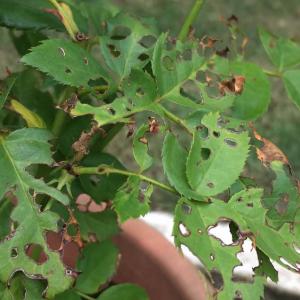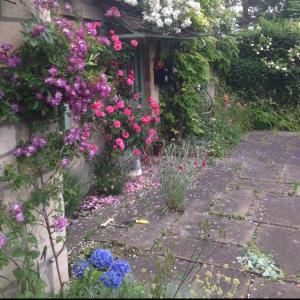文章
Dummer. ゛☀
2017年08月04日

Materials
Spade, hand pruners, loppers, gloves, garden hose and watering wand or nozzle, Miracle-Gro® Garden Soil for Roses or Miracle-Gro® Garden Soil for Flowers or Miracle-Gro® Potting Mix, Miracle-Gro® Shake ’n Feed® Rose & Bloom Plant Food, garden rake, bucket, measuring tape.

How to Choose the Right Roses for Your Garden
Roses are not one size fits all—there are multiple types, from shrub roses to hybrid tea roses, climbing roses, and groundcover roses. The first step in growing roses is selecting the right rose bush or rose plant for your yard or garden. Roses, regardless of the type, grow best in full sun in well-drained soil. Putting the right plant in the right place goes a long way toward growing healthy plants. So which rose is right for you?
Shrub roses are great choices for landscape beds and foundation plantings next to the house. They tend to bloom a few times during the season. There are many new options that are pest and disease resistant. Groundcover roses add a bit of color to hot, dry, sunny areas. They’re drought-tolerant and beautiful when allowed to spill over a wall. Climbing roses are a little less cold hardy than shrub roses, so check the plant information carefully when purchasing. Hybrid teas are the classic ?bouquet? rose, and require the most hands-on care. They’ll reward you with gorgeous cut flowers, though.
How to Plant Roses
Once you’ve selected the sunny, well-drained spot for planting, it’s time to prepare the soil. The way you plant a rose depends on whether it is bareroot (usually sold with roots in a bag with some moist wood chips but no soil) or growing in a pot (container-grown) when you get it.
To plant bareroot roses:
1.Remove plants from their packaging and soak their roots in a bucket of tepid water for an hour.
2.Use a measuring tape to measure the length of the roots (from the tip of the roots to where the roots meet the stem).
3.Dig a hole that is two inches shallower than the length of the roots and twice as wide.
4.Mix equal parts of Miracle-Gro® Garden Soil for Roses (or Miracle-Gro® Garden Soil for Flowers) and the soil removed from the planting hole. If planting in a container, use with Miracle-Gro® Potting Mix. Either way, you are helping ensure that roses receive ample nutrition while establishing new roots in the garden.
5.Using the soil mixture (or potting mix for containers), build a mound in the planting hole that almost reaches to top of the hole.
6.Spread the roots evenly over the mound.
7.Fill in the hole completely with more of the soil mixture, covering the roots. Pack it firmly.
8.Spread a 2-inch layer of mulch on the surface of the planting hole, to help conserve moisture in the soil.
9.Water thoroughly.
To plant roses that come in containers:
1.Remove rose plant from the pot.
2.Use measuring tape to measure the height of the root ball.
3.Dig a planting hole that is two inches shallower than the height of the root ball, and twice as wide.
4.Place the plant in the planting hole. The top of the root ball should be about an inch above the edge of the hole. (Soil will settle over time, so you don’t want to plant the rose too deep.)
5.Mix equal parts of Miracle-Gro® Garden Soil for Roses (or Miracle-Gro® Garden Soil for Flowers) and the soil removed from the planting hole, and fill in around the shrub. Cover the top of the root ball with an inch of the soil mixture. If planting in a pot, use Miracle-Gro® Potting Mix.
6.Cover the surface of the planting hole with 2 inches of mulch, to help keep soil moist.
7.Water thoroughly.

How to Water Roses
Roses need well-drained soil to flourish, but that doesn’t mean they don’t need water. Regular watering is especially important as roses are establishing new roots in the landscape. Roses are fairly drought-tolerant after the first growing season.
For the first 2 months after you first plant a rosebush, give the plant a deep, thorough soaking 2-3 times per week with a hose. If you reach your finger into the soil and the top 2 inches are still moist, however, wait a few days.
For the remainder of the first growing season, water thoroughly a couple of times per week.. Once plants are established in the landscape, you will only need to water roses during drought conditions. If the leaves take on a greyish cast or being to curl, you’ll know the plants need water.
Whenever you water, void getting water on the leaves (an invitation to disease) by directly aiming the water stream at the roots of each plant.
How to Fertilize Roses
First, allow the plants to get settled in the garden. Then, after the first month, feed plants with Miracle-Gro® Shake ’n Feed® Rose & Bloom Plant Food to help replace the nutrition your growing roses have taken up from the soil, so your plant will produce beautiful blooms. Be sure to follow label directions.
How to Prune Roses
Prune roses in very early spring, while they are still dormant.
Prune to reduce overall size by cutting each branch back to an outward-facing bud. Roses can be cut back hard, but we don’t recommend removing more than one-third to one-half of the overall growth. Wear gloves and long sleeves to protect your hands, and use loppers or hand pruners. Do not shear roses.
Remove old, diseased, or dead wood by cutting the affected branches down to the bottom of the plant.
Promote airflow within the shrub by removing crossing or rubbing branches within the center of the shrub. Always cut back to an outward-facing bud. You can remove up to one-half of the growth from within the center of the shrub to promote air movement.

How to Control Rose Pests
Roses can be affected by a variety of fungal, bacterial, and insect issues. Providing the plants with the good care outlined above goes a long way toward preventing these problems, but it isn’t fail-safe. Treat problems with aphids, Japanese beetles, and other pests with Ortho® Rose & Flower Insect Killer Ready-to-Use. For diseases such as black spot and rust, use Ortho® Rose & Flower Insect & Disease Control. Or, consult with your local cooperative extension service for the best course of treatment.
How to Grow Roses: Recap
Select the best type of rose for your garden location.
Prepare the soil and plant the rose bush according to instructions (bareroot or container-grown).
Water regularly while the plant is getting established, and in times of drought after the first growing season.
Feed roses regularly with Miracle-Gro® plant food.
Prune roses when dormant.
Watch out for pests and disease.
Spade, hand pruners, loppers, gloves, garden hose and watering wand or nozzle, Miracle-Gro® Garden Soil for Roses or Miracle-Gro® Garden Soil for Flowers or Miracle-Gro® Potting Mix, Miracle-Gro® Shake ’n Feed® Rose & Bloom Plant Food, garden rake, bucket, measuring tape.

How to Choose the Right Roses for Your Garden
Roses are not one size fits all—there are multiple types, from shrub roses to hybrid tea roses, climbing roses, and groundcover roses. The first step in growing roses is selecting the right rose bush or rose plant for your yard or garden. Roses, regardless of the type, grow best in full sun in well-drained soil. Putting the right plant in the right place goes a long way toward growing healthy plants. So which rose is right for you?
Shrub roses are great choices for landscape beds and foundation plantings next to the house. They tend to bloom a few times during the season. There are many new options that are pest and disease resistant. Groundcover roses add a bit of color to hot, dry, sunny areas. They’re drought-tolerant and beautiful when allowed to spill over a wall. Climbing roses are a little less cold hardy than shrub roses, so check the plant information carefully when purchasing. Hybrid teas are the classic ?bouquet? rose, and require the most hands-on care. They’ll reward you with gorgeous cut flowers, though.
How to Plant Roses
Once you’ve selected the sunny, well-drained spot for planting, it’s time to prepare the soil. The way you plant a rose depends on whether it is bareroot (usually sold with roots in a bag with some moist wood chips but no soil) or growing in a pot (container-grown) when you get it.
To plant bareroot roses:
1.Remove plants from their packaging and soak their roots in a bucket of tepid water for an hour.
2.Use a measuring tape to measure the length of the roots (from the tip of the roots to where the roots meet the stem).
3.Dig a hole that is two inches shallower than the length of the roots and twice as wide.
4.Mix equal parts of Miracle-Gro® Garden Soil for Roses (or Miracle-Gro® Garden Soil for Flowers) and the soil removed from the planting hole. If planting in a container, use with Miracle-Gro® Potting Mix. Either way, you are helping ensure that roses receive ample nutrition while establishing new roots in the garden.
5.Using the soil mixture (or potting mix for containers), build a mound in the planting hole that almost reaches to top of the hole.
6.Spread the roots evenly over the mound.
7.Fill in the hole completely with more of the soil mixture, covering the roots. Pack it firmly.
8.Spread a 2-inch layer of mulch on the surface of the planting hole, to help conserve moisture in the soil.
9.Water thoroughly.
To plant roses that come in containers:
1.Remove rose plant from the pot.
2.Use measuring tape to measure the height of the root ball.
3.Dig a planting hole that is two inches shallower than the height of the root ball, and twice as wide.
4.Place the plant in the planting hole. The top of the root ball should be about an inch above the edge of the hole. (Soil will settle over time, so you don’t want to plant the rose too deep.)
5.Mix equal parts of Miracle-Gro® Garden Soil for Roses (or Miracle-Gro® Garden Soil for Flowers) and the soil removed from the planting hole, and fill in around the shrub. Cover the top of the root ball with an inch of the soil mixture. If planting in a pot, use Miracle-Gro® Potting Mix.
6.Cover the surface of the planting hole with 2 inches of mulch, to help keep soil moist.
7.Water thoroughly.

How to Water Roses
Roses need well-drained soil to flourish, but that doesn’t mean they don’t need water. Regular watering is especially important as roses are establishing new roots in the landscape. Roses are fairly drought-tolerant after the first growing season.
For the first 2 months after you first plant a rosebush, give the plant a deep, thorough soaking 2-3 times per week with a hose. If you reach your finger into the soil and the top 2 inches are still moist, however, wait a few days.
For the remainder of the first growing season, water thoroughly a couple of times per week.. Once plants are established in the landscape, you will only need to water roses during drought conditions. If the leaves take on a greyish cast or being to curl, you’ll know the plants need water.
Whenever you water, void getting water on the leaves (an invitation to disease) by directly aiming the water stream at the roots of each plant.
How to Fertilize Roses
First, allow the plants to get settled in the garden. Then, after the first month, feed plants with Miracle-Gro® Shake ’n Feed® Rose & Bloom Plant Food to help replace the nutrition your growing roses have taken up from the soil, so your plant will produce beautiful blooms. Be sure to follow label directions.
How to Prune Roses
Prune roses in very early spring, while they are still dormant.
Prune to reduce overall size by cutting each branch back to an outward-facing bud. Roses can be cut back hard, but we don’t recommend removing more than one-third to one-half of the overall growth. Wear gloves and long sleeves to protect your hands, and use loppers or hand pruners. Do not shear roses.
Remove old, diseased, or dead wood by cutting the affected branches down to the bottom of the plant.
Promote airflow within the shrub by removing crossing or rubbing branches within the center of the shrub. Always cut back to an outward-facing bud. You can remove up to one-half of the growth from within the center of the shrub to promote air movement.

How to Control Rose Pests
Roses can be affected by a variety of fungal, bacterial, and insect issues. Providing the plants with the good care outlined above goes a long way toward preventing these problems, but it isn’t fail-safe. Treat problems with aphids, Japanese beetles, and other pests with Ortho® Rose & Flower Insect Killer Ready-to-Use. For diseases such as black spot and rust, use Ortho® Rose & Flower Insect & Disease Control. Or, consult with your local cooperative extension service for the best course of treatment.
How to Grow Roses: Recap
Select the best type of rose for your garden location.
Prepare the soil and plant the rose bush according to instructions (bareroot or container-grown).
Water regularly while the plant is getting established, and in times of drought after the first growing season.
Feed roses regularly with Miracle-Gro® plant food.
Prune roses when dormant.
Watch out for pests and disease.
1
2
文章
linpei
2017年06月30日

Roses and roses and roses look the same, but not really. The cultivation of rose flowers need to pay attention to what aspects, and then from the soil, water, fertilizer, pruning and so on several aspects to introduce to you about the cultivation methods of roses.
About soil:
Roses do not select soil, but whether they are planted or planted, they are best grown in sandy soil rich in humus.
About moisture:
Rose like run and afraid of wet avoid waterlogging, from germination to flowering, water can be more appropriate to pouring a little, but not for the degree of soil moist waterlogging, after watering flowers can not be too much to see the soil dry and wet, rainy season should pay attention to drainage.
About fertilizer:
It is also like fertilizer, barren, March can be 1 to 2 times with nitrogen based fertilizer, promote the growth of branches, April, May 2 times to 3 times the phosphorus and potassium based fertilizers, and promote its multi bud flowering, after flowering Zaishi a rejuvenation after fertilizer can no longer rose fertilization system positive flower, it is warm, cold, North and south, can overwinter safely outdoors.
About pruning:
The germination ability of the rose is vigorous and the growth is luxuriant. If it is not pruned in time, it is easy to produce diseases and insect pests under the condition of hot and humid, lack of light and poor ventilation. Therefore, a pruning should be carried out after the flower.
About plant diseases and insect pests:
In the rainy and humid, poor ventilation, poor sunshine conditions rose susceptible to powdery mildew, once discovered will cut the diseased branches destroyed, in order to avoid infection, and spraying low concentration of LSSS or Bordeaux, Topsin solution, to prevent the spread of the disease.
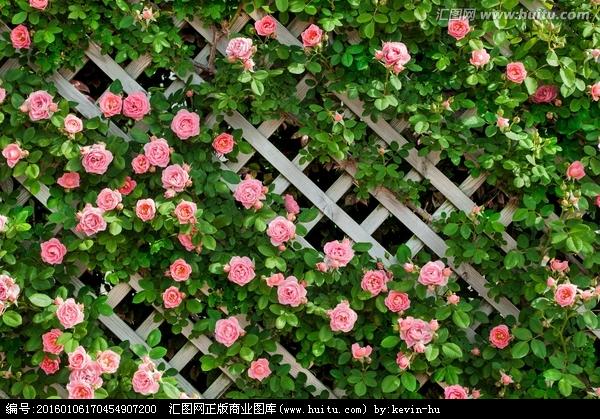
About soil:
Roses do not select soil, but whether they are planted or planted, they are best grown in sandy soil rich in humus.
About moisture:
Rose like run and afraid of wet avoid waterlogging, from germination to flowering, water can be more appropriate to pouring a little, but not for the degree of soil moist waterlogging, after watering flowers can not be too much to see the soil dry and wet, rainy season should pay attention to drainage.
About fertilizer:
It is also like fertilizer, barren, March can be 1 to 2 times with nitrogen based fertilizer, promote the growth of branches, April, May 2 times to 3 times the phosphorus and potassium based fertilizers, and promote its multi bud flowering, after flowering Zaishi a rejuvenation after fertilizer can no longer rose fertilization system positive flower, it is warm, cold, North and south, can overwinter safely outdoors.
About pruning:
The germination ability of the rose is vigorous and the growth is luxuriant. If it is not pruned in time, it is easy to produce diseases and insect pests under the condition of hot and humid, lack of light and poor ventilation. Therefore, a pruning should be carried out after the flower.
About plant diseases and insect pests:
In the rainy and humid, poor ventilation, poor sunshine conditions rose susceptible to powdery mildew, once discovered will cut the diseased branches destroyed, in order to avoid infection, and spraying low concentration of LSSS or Bordeaux, Topsin solution, to prevent the spread of the disease.

3
0
文章
lenny
2017年05月23日
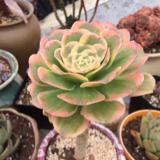
If you have a limited space and you want to create a small rose garden there then growing roses in containers is the best option for you.

Blooming roses are among the most beautiful ornamental plants that can be grown in the garden. It is hardly surprising that many rose lovers that have limited space also desire to grow them. Fortunately, growing roses in containers on a balcony, patio or terrace is possible, this way you can create a small rose garden. Except large variety of roses, you can grow all type of roses in containers.
Choose Roses Wisely
Roses are one of the most diverse plants on our planet. There are 14, 000 varieties of roses of which some can withstand the – 40 F extreme cold temperature then there are some rose varieties suitable for tropics that bear up to 110 F and still blooms. Choose roses wisely, according to your climate.
You should also consider the space you have, decide whether you want to grow a small rose garden or just a few roses.
Type of Roses to Consider
Miniature Roses
Miniature Roses are comparatively easy to grow than all other rose types, they are simply the mini version of large roses and are ideal balcony roses, and good for roofs and patios. You can also grow them in hanging baskets and railing planters. On a balcony, you can also grow miniature climbing roses such as red cascade, to use up your vertical space. Miniature Roses produces small flowers of about 1”-2” inch size in red, yellow, pink, white, peach, orange and many other colors. Generally, the bushes grow to no more than 18 inches in height.
Hybrid Teas
If you like large roses, grow hybrid tea roses. They flower less but phenomenal. One flower on a long, straight and upright stem. Hybrid Tea Roses can be as tall as 6 feet. Each bloom can be up to 5″ in diameter. Hybrid Tea Roses are one of the world’s most popular types of roses due to their color and large blooms.
Floribunda
Floribunda roses produce a cluster of flowers on top of each stem, their blooms are smaller in compare to tea roses. These roses can grow up to 3 feet tall.
Patio Roses
Patio roses are undemanding small bushes, which grows between 18 to 24 inches tall. They have a compact growing habit and thrive well in containers.
To learn more about rose varieties for containers read this post.

Roses Must have Suitable Containers
The size of the container should be medium to large to grow rose bushes. Larger varieties require extensive, deep pot with a minimum diameter of 40 cm, with large drainage holes in the bottom. On the other hand, low growing, medium to small sized roses can be grown in containers with a diameter of 25 – 30 cm.
Don’t overlook the look of containers, potted rose plants look more beautiful if you choose a handsome container for them.
While choosing container look at their bottom for drainage holes, good drainage is essential for roses. If there is insufficient drainage, make some holes.
When and How to Plant Roses to Make a Small Rose Garden
Best time for planting roses is spring to early summer. After purchasing roses transplant them as soon as possible to new, larger pots as they usually are sold in very small containers.
For the USDA zones 9 – 11 and other subtropical and tropical parts, rose can be planted from any time between fall (autumn) to winter.
If you have bought bare root roses you should keep their roots submerged for an hour or two in the water, making them absorb the moisture, this will make them easier to adopt in a new place.
Then put on damp root ball of your rose plant into the pot. While planting, ensure that rose placed in soil just deep as it used to grow in the previous pot.
Water well the freshly planted roses and for a few days place them in a sheltered place that receives only a few hours of morning sun, later on, move the containers to the position that is sufficiently bright and receives the sun at least for 7 hours as no roses, in the long run, can tolerate shade.
Throughout the season, roses in containers should be watered deeply and moderately because they do not tolerate desiccation.
After about 2 to 3 weeks of planting, roses are ready to be fertilized. One thing you should know that roses are heavy feeders. Fertilize roses using the special rose mix fertilizer, which you can buy from a garden center, you can also fertilize them with any all-purpose fertilizer. Application of manure and compost also helps the rose plants.
Overwintering Roses
The main advantage of growing plants on a balcony is that it remains comparatively warmer than regular gardens. Still you should do some things to warm the pots and plants, do heavy mulching with organic matter and protect them from the cool air.
In very low temperatures in winters, keep your potted roses indoors.
For tropics it is opposite, you’ll need to care roses in summer. Cool weather varieties will die itself, so grow rose varieties that are suitable for tropics and save them from scorching the sun when it is overheadTips

Except North facing, you can grow roses on every type of balcony.
If you want to grow roses on South facing balcony, protect them from afternoon sun (especially in warm climates)
Every spring or in the beginning of growing season replace the potting soil or at least replace the top layer with compost or manure.
Always cut the faded flowers, this stimulates the growth of new buds.
Read more on rose care tips

Blooming roses are among the most beautiful ornamental plants that can be grown in the garden. It is hardly surprising that many rose lovers that have limited space also desire to grow them. Fortunately, growing roses in containers on a balcony, patio or terrace is possible, this way you can create a small rose garden. Except large variety of roses, you can grow all type of roses in containers.
Choose Roses Wisely
Roses are one of the most diverse plants on our planet. There are 14, 000 varieties of roses of which some can withstand the – 40 F extreme cold temperature then there are some rose varieties suitable for tropics that bear up to 110 F and still blooms. Choose roses wisely, according to your climate.
You should also consider the space you have, decide whether you want to grow a small rose garden or just a few roses.
Type of Roses to Consider

Miniature Roses
Miniature Roses are comparatively easy to grow than all other rose types, they are simply the mini version of large roses and are ideal balcony roses, and good for roofs and patios. You can also grow them in hanging baskets and railing planters. On a balcony, you can also grow miniature climbing roses such as red cascade, to use up your vertical space. Miniature Roses produces small flowers of about 1”-2” inch size in red, yellow, pink, white, peach, orange and many other colors. Generally, the bushes grow to no more than 18 inches in height.
Hybrid Teas
If you like large roses, grow hybrid tea roses. They flower less but phenomenal. One flower on a long, straight and upright stem. Hybrid Tea Roses can be as tall as 6 feet. Each bloom can be up to 5″ in diameter. Hybrid Tea Roses are one of the world’s most popular types of roses due to their color and large blooms.
Floribunda
Floribunda roses produce a cluster of flowers on top of each stem, their blooms are smaller in compare to tea roses. These roses can grow up to 3 feet tall.
Patio Roses
Patio roses are undemanding small bushes, which grows between 18 to 24 inches tall. They have a compact growing habit and thrive well in containers.
To learn more about rose varieties for containers read this post.

Roses Must have Suitable Containers
The size of the container should be medium to large to grow rose bushes. Larger varieties require extensive, deep pot with a minimum diameter of 40 cm, with large drainage holes in the bottom. On the other hand, low growing, medium to small sized roses can be grown in containers with a diameter of 25 – 30 cm.
Don’t overlook the look of containers, potted rose plants look more beautiful if you choose a handsome container for them.
While choosing container look at their bottom for drainage holes, good drainage is essential for roses. If there is insufficient drainage, make some holes.
When and How to Plant Roses to Make a Small Rose Garden
Best time for planting roses is spring to early summer. After purchasing roses transplant them as soon as possible to new, larger pots as they usually are sold in very small containers.
For the USDA zones 9 – 11 and other subtropical and tropical parts, rose can be planted from any time between fall (autumn) to winter.
If you have bought bare root roses you should keep their roots submerged for an hour or two in the water, making them absorb the moisture, this will make them easier to adopt in a new place.
Then put on damp root ball of your rose plant into the pot. While planting, ensure that rose placed in soil just deep as it used to grow in the previous pot.
Water well the freshly planted roses and for a few days place them in a sheltered place that receives only a few hours of morning sun, later on, move the containers to the position that is sufficiently bright and receives the sun at least for 7 hours as no roses, in the long run, can tolerate shade.
Throughout the season, roses in containers should be watered deeply and moderately because they do not tolerate desiccation.
After about 2 to 3 weeks of planting, roses are ready to be fertilized. One thing you should know that roses are heavy feeders. Fertilize roses using the special rose mix fertilizer, which you can buy from a garden center, you can also fertilize them with any all-purpose fertilizer. Application of manure and compost also helps the rose plants.
Overwintering Roses
The main advantage of growing plants on a balcony is that it remains comparatively warmer than regular gardens. Still you should do some things to warm the pots and plants, do heavy mulching with organic matter and protect them from the cool air.
In very low temperatures in winters, keep your potted roses indoors.
For tropics it is opposite, you’ll need to care roses in summer. Cool weather varieties will die itself, so grow rose varieties that are suitable for tropics and save them from scorching the sun when it is overheadTips

Except North facing, you can grow roses on every type of balcony.
If you want to grow roses on South facing balcony, protect them from afternoon sun (especially in warm climates)
Every spring or in the beginning of growing season replace the potting soil or at least replace the top layer with compost or manure.
Always cut the faded flowers, this stimulates the growth of new buds.
Read more on rose care tips
3
0
文章
Hande Salcan
2017年05月23日


We’ve all loved ’em… the ever dreamed about, garden #hydrangea . So popular, they are the number one wedding flower after roses. So beloved, few people have no memories of a hydrangea moment…yes, especially us girls… They are romantic, and amazing. Sigh…. The good news is, there is a hydrangea to fit most gardens in most areas of the country. Shade or sun, acid soil or alkaline. Yes, they can be a little finicky. Yes, they are absolutely worth it! Here is the skinny on growing the best hydrangeas, for garden or table. (Or both!)
Although most of us probably think of the old fashioned mophead hydrangea (H. macrophylla) first, with those amazing balls of bloom in pink or blue, there are other varieties. Oakleaf hydrangeas grow well in partial shade, and lace cap hydrangeas have a more delicate flower. There is also the more heat tolerant PeeGee hydrangea, H. paniculata. And if that isn’t enough variety, there are now the new reblooming hydrangeas, like “Endless Summer”. First, basic hydrangea care, then we will look at the different varieties so that you can choose the right one for your garden!
Hydrangea Basics
Sun and Shade
Most hydrangeas prefer morning sun and afternoon shade, and don’t deal well with hot climates. Coastal climates are ideal, as are cool summer areas. Both too much heat and too little sun can contribute to poor performance for old fashioned hydrangeas. PeeGee hydrangeas deal much better with heat. Oak leaf hydrangeas are perfect for partial shade areas. No hydrangea will bloom in deep shade.
Water and Fertilizer
Hydrangeas prefer to be evenly moist, and love a fertile spoil. That having been said, when using commercial fertilizers, it’s often advised to use half strength liquid fertilizer so you don’t stimulate too much leaf growth at the expense of the flowers.
Pruning
Most (except re-bloomers) bloom on old wood, so severe pruning is not necessary. Prune away dead wood each spring, and dead head the flowers that are past their prime to promote the most flowers on each bush. PeeGee and Annabelle hydrangeas are more tolerant.
Soil
Hydrangeas prefer soil rich in organic matter. You may have heard that you can change the color of a hydrangeas blooms based on soil composition. It’s true that the pink and blue varieties are influenced by the soil ph. You can change a pink hydrangea to blue by adding aluminum sulfate to the soil to make it more acidic. It is pretty difficult to change a blue hydrangea to pink…
Problems
The biggest problems hydrangea gardeners have is lack of bloom… This is usually caused by one of three things… a late freeze, using a variety that is not intended for your climate, or pruning too much of the old wood away. KariAnne of Thistlewood Farms has a mantel full of beautiful blooms that convince me she’s found the secret! Check out her advice on getting hydrangeas to bloom.

Varieties
Mopheads – Hydrangea macrophylla. Traditional pink or blue hydrangeas. Hate summer heat.
(Photo – Mopheads on right, Lacecaps on left)

Lacecaps – Hydrangea macrophylla normalis. Lacey and more easily naturalized into the average landscape, these shrubs are less formal, but still amazing specimen plants.
Oakleaf – H. arborescens. Oakleaf hydrangea had oak shaped leaves that turn lovely purple and red in the fall, and conical shaped white flowers that bloom in summer. More tolerant to hot summers, tolerant to shade, and tolerant to drier soil. Wonderful garden plant!
PeeGee – Hydrangea paniculata. Large conical white to pink blooms, Peegee’s tolerate cold and require several hours of sun a day. They can grow quite large, and are tolerant to pruning, so can be used as a hedge. They also bloom a little later, August and September. They are the only variety that can be pruned into tree form.

Cold zone hydrangeas – Hydrangea arborescens “Annabelle” is a large white flowering variety that blooms and grows well in cold climate zones. Hardy down to zone 3, these flowers can be up to 10 inches across!

Reblooming – Hydrangea macrophylla, the most popular new gaiety of the reblooming mop head is “Endless Summer”. These tend to be smaller shrubs, prefer partial shade, and bloom pink or blue. Reblooming several times over the summer, they are a popular choice for large containers as well.

It’s worth a little extra effort to learn about growing hydrangeas… they can survive in a garden for generations, and are a beloved flower that every gardener should have the chance to grow.
UPDATE: Just ran across this new hydrangea from Wayside Gardens I just had to share… Hydrangea ‘Next Generation Pistachio’ is a compact grower, just 3-5 feet, loves a shady afternoon, and has an amazing lime green petal edged with pink! Zones 5-9.

0
2
文章
lenny
2017年03月15日


When spring comes and the ground is thawed, it is time to start planting your rose garden. Roses have been a cherished aphrodisiac since biblical times. They have been around for over 3000 years, yet they still hold a particular mystery and fascination, not to mention the fact that they just look and smell good!
One of the most important rules of growing roses is to plant the rose bush in an area that receives around 4 to 6 hours of sunlight every day.
It is preferable not to plant too many trees or other plants around the rose bush because most of these are likely to either mix with the rose or stifle it’s growth. If you are replacing an old rose bush, approximately 1 1/2 cubic feet of old soil should be removed, and fresh soil added to replace it. When positioning your rose in the garden or landscape, consider the growth habit of the rose.
For example, place climbers and ramblers along fences, trellises, or next to arches or pergolas. This location offers them free range of growth, and optimal potential for the showiest blooms.
Roses also look beautiful in island garden beds interplanted with perennials. Miniature roses make great edging plants in front of their taller cousins. Planted singly, shrub roses make excellent specimen plants or they can be clustered to make a flowering hedge. You can also use them to camouflage unsightly garden objects.
Dig a hole large enough for the root mass and loosen the bottom of the hole. You should add bone meal, which is a slow acting source of phosphorus that leads to healthy root growth in the rose plant.

3
2
文章
Lisa
2017年02月20日

There are literally hundreds of types of #roses that you can grow in your garden. With such a selection to choose from, it can be extremely difficult to choose the rose that’s right for you. To make this task a bit easier, We’ve outlined a few important factors you should consider, and explained some of the different types of roses to aid in your search.

Tips on Choosing Roses
1. Color may seem trivial at first glance, but it’s usually an important factor to those that want to grow roses. Usually it is simply a matter of personal preference, but you may want to try creating a complimentary color palette for your rose garden.
2. The final growth height of a rose should be considered as it would be unattractive to grow roses that are higher than the area of the garden that it grows in. Some roses can grow to be as high as 20 feet.
3. If you live in an area that is prone to cold winters, you would certainly want a rose that could survive during the off season.
4. If certain fragrances invoke an allergic reaction, you’ll want to plant roses that have a softer fragrance than the others.
5. It’s smart gardening to learn what the advantages and disadvantages would be if you were to choose certain roses over others.
6. You will want to consider the size of your garden space, so that you can ensure proper exposure to the air and other elements as well.
7. If you are hoping to make your roses into bouquets, you will want to know if they can be cut. Hybrid teas can. Some roses will fall apart at the petals if they are cut.
8. You should also consider what other types of flowers or plants you intend on adding to the rose’s environment. You want to add plants and flowers that will not create a damaging environment to your rose’s ecosystem.

Some Common Types of Roses
After you get a sense of the type of roses that you would like to plant, you’ll naturally want to know which types of roses best fit with your planting ideas. There are too many varieties of roses to list here, but this list covers some of the most popular. You should consult your nearest garden center for advice on whether your choice is fitting to your garden’s abilities.
Landscape roses – Landscape roses are great for the novice gardener. They are disease resistant, and require a little bit less maintenance. Hybrid teas are not good for the novice.
Climbing Roses – These roses are different from the regular roses that are planted as they are trained to grow upward like vines. Most people like to use these for trellises, or buildings. Some of them are hybrid teas, wichuraine, and large flowered climbers. They are a beautiful addition to the look of one’s house.
Shrub Roses – Shrub roses like the beautiful rugosa are both long blooming, and disease resistant. These are also great for the novice planter. They are gorgeous even when they are not in bloom because the foliage is so pretty.

Old Garden Roses – These roses are not very good for those with severe allergies to strong fragrances because they have a strong fragrant odor. However, they are disease resistant and continue to bloom for months at a time.
The Modern Rose – These are very special roses because they are the result of cross breeding the hybrid tea with the polyanthus. They are also referred to as Floribunda. They are a beautiful combination of the best those two flowers have to offer. They are long blooming, fragrant, and they are great for cutting.
Miniature Roses – Miniature roses are exactly what they sound like. They have all of the fragrance and beauty of a regular rose, but they have smaller blooms. These particular roses are great for indoor planting.
While note all inclusive, this article should be a great help in getting you started on the way to having your very own, gorgeous rose garden.

Tips on Choosing Roses
1. Color may seem trivial at first glance, but it’s usually an important factor to those that want to grow roses. Usually it is simply a matter of personal preference, but you may want to try creating a complimentary color palette for your rose garden.
2. The final growth height of a rose should be considered as it would be unattractive to grow roses that are higher than the area of the garden that it grows in. Some roses can grow to be as high as 20 feet.
3. If you live in an area that is prone to cold winters, you would certainly want a rose that could survive during the off season.
4. If certain fragrances invoke an allergic reaction, you’ll want to plant roses that have a softer fragrance than the others.
5. It’s smart gardening to learn what the advantages and disadvantages would be if you were to choose certain roses over others.
6. You will want to consider the size of your garden space, so that you can ensure proper exposure to the air and other elements as well.
7. If you are hoping to make your roses into bouquets, you will want to know if they can be cut. Hybrid teas can. Some roses will fall apart at the petals if they are cut.
8. You should also consider what other types of flowers or plants you intend on adding to the rose’s environment. You want to add plants and flowers that will not create a damaging environment to your rose’s ecosystem.

Some Common Types of Roses
After you get a sense of the type of roses that you would like to plant, you’ll naturally want to know which types of roses best fit with your planting ideas. There are too many varieties of roses to list here, but this list covers some of the most popular. You should consult your nearest garden center for advice on whether your choice is fitting to your garden’s abilities.
Landscape roses – Landscape roses are great for the novice gardener. They are disease resistant, and require a little bit less maintenance. Hybrid teas are not good for the novice.
Climbing Roses – These roses are different from the regular roses that are planted as they are trained to grow upward like vines. Most people like to use these for trellises, or buildings. Some of them are hybrid teas, wichuraine, and large flowered climbers. They are a beautiful addition to the look of one’s house.
Shrub Roses – Shrub roses like the beautiful rugosa are both long blooming, and disease resistant. These are also great for the novice planter. They are gorgeous even when they are not in bloom because the foliage is so pretty.

Old Garden Roses – These roses are not very good for those with severe allergies to strong fragrances because they have a strong fragrant odor. However, they are disease resistant and continue to bloom for months at a time.
The Modern Rose – These are very special roses because they are the result of cross breeding the hybrid tea with the polyanthus. They are also referred to as Floribunda. They are a beautiful combination of the best those two flowers have to offer. They are long blooming, fragrant, and they are great for cutting.
Miniature Roses – Miniature roses are exactly what they sound like. They have all of the fragrance and beauty of a regular rose, but they have smaller blooms. These particular roses are great for indoor planting.
While note all inclusive, this article should be a great help in getting you started on the way to having your very own, gorgeous rose garden.
0
0
文章
TwainLeo
2017年02月20日

When spring arrives, and the ground is thawed, it is time to start planting your #rose garden. Roses date back to biblical times and have been a considered a cherished aphrodisiac then and still are today. Roses hold particular mystery and fascination, not to mention the fact that they just look and smell good!
Roses require 4 to 6 hours of sunlight everyday. It is preferable not to plant too many trees or other plants around the rose bush because most of these are likely to either mix with the rose or stifle its growth. If you are replacing an old rose bush, approximately 1 1/2 cubic feet of old soil should be removed and fresh soil added to replace it.

When positioning your rose in the garden or landscape, consider the growth habit of the rose. For example, place climbers and ramblers along fences, trellises, or next to arches or pergolas. This location offers them free range of growth, and optimal potential for the biggest and showiest blooms.
Roses also look beautiful in island beds mixed with perennials.
Miniature roses make great edging plants in front of their taller cousins.
Planted singly, shrub roses make excellent specimen plants or they can be clustered to make a flowering hedge. You can also use them to camouflage unsightly garden objects.

Dig a hole large enough for the root mass and loosen the bottom of the hole. You should add bone meal, which is a slow acting source of phosphorus that leads to healthy root growth in the rose plant. Special care should be taken with the planting depth. It varies according to the climate you live in. If you live in a colder area, plant a bit deeper and consult with the people growing roses in your area. If you are buying potted roses, you should plant them about 1 inch deeper than their potted level.
The plant should be placed in the hole carefully, and the hole refilled with soil, covering the roots completely. Before making the final covering, water the rose plant and let it absorb the water. After this, water the plant more and mound the soil about 6 inches high. The dome will keep the stems from drying out until the plant is rooted. Gradually remove the excess soil as the leaves open.
The best time to plant roses varies depending on the winter temperature. Where temperatures do not drop below -10 degrees F; either fall or spring planting is satisfactory. If you live in an area where winter temperatures go below -10 degrees F, spring planting is preferred. Plants should be planted in a dormant condition if purchased bare root, but container-grown plants may be planted throughout the growing season.
Spacing of the rose plant is highly influenced by the temperature. In regions where winters are severe, the rose plant does not grow as large as in mild climates. Taking this into consideration, hybrid tea roses should be spaced 1 1/2 to 3 feet apart. Large vigorous growers, such as hybrid perpetual need 3 to 5 feet of space, and the climbers need from 8 to 10 feet of space.
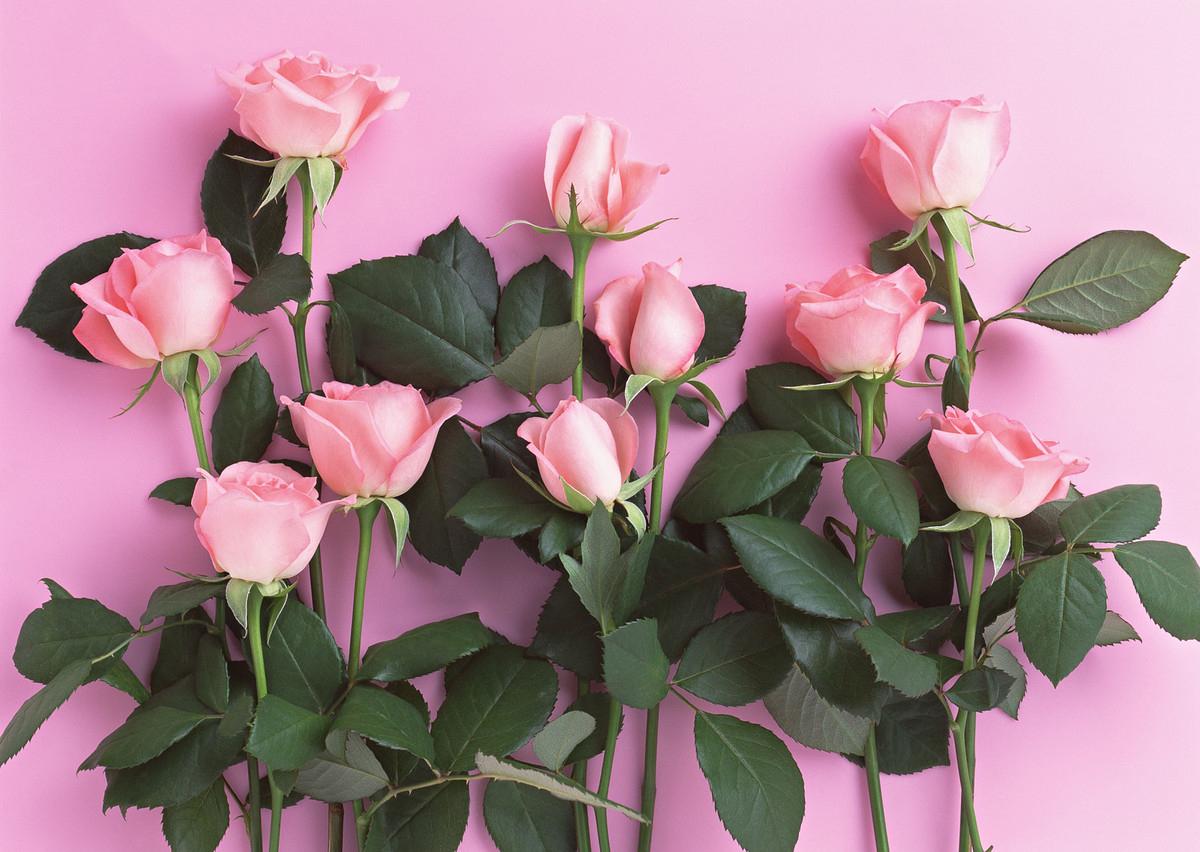
If the winter temperature is below 10 degrees F, roses can grow healthy if proper care is taken. The gardener must prepare for that cold, wet reality as he revels in the summer air conditioning.
In zones 7 and colder, the roses enjoy their last fertilization of the season by August 15 to limit the emergence of new rose canes, which will almost certainly not survive the winter.
Roses require 4 to 6 hours of sunlight everyday. It is preferable not to plant too many trees or other plants around the rose bush because most of these are likely to either mix with the rose or stifle its growth. If you are replacing an old rose bush, approximately 1 1/2 cubic feet of old soil should be removed and fresh soil added to replace it.

When positioning your rose in the garden or landscape, consider the growth habit of the rose. For example, place climbers and ramblers along fences, trellises, or next to arches or pergolas. This location offers them free range of growth, and optimal potential for the biggest and showiest blooms.
Roses also look beautiful in island beds mixed with perennials.
Miniature roses make great edging plants in front of their taller cousins.
Planted singly, shrub roses make excellent specimen plants or they can be clustered to make a flowering hedge. You can also use them to camouflage unsightly garden objects.

Dig a hole large enough for the root mass and loosen the bottom of the hole. You should add bone meal, which is a slow acting source of phosphorus that leads to healthy root growth in the rose plant. Special care should be taken with the planting depth. It varies according to the climate you live in. If you live in a colder area, plant a bit deeper and consult with the people growing roses in your area. If you are buying potted roses, you should plant them about 1 inch deeper than their potted level.
The plant should be placed in the hole carefully, and the hole refilled with soil, covering the roots completely. Before making the final covering, water the rose plant and let it absorb the water. After this, water the plant more and mound the soil about 6 inches high. The dome will keep the stems from drying out until the plant is rooted. Gradually remove the excess soil as the leaves open.
The best time to plant roses varies depending on the winter temperature. Where temperatures do not drop below -10 degrees F; either fall or spring planting is satisfactory. If you live in an area where winter temperatures go below -10 degrees F, spring planting is preferred. Plants should be planted in a dormant condition if purchased bare root, but container-grown plants may be planted throughout the growing season.
Spacing of the rose plant is highly influenced by the temperature. In regions where winters are severe, the rose plant does not grow as large as in mild climates. Taking this into consideration, hybrid tea roses should be spaced 1 1/2 to 3 feet apart. Large vigorous growers, such as hybrid perpetual need 3 to 5 feet of space, and the climbers need from 8 to 10 feet of space.

If the winter temperature is below 10 degrees F, roses can grow healthy if proper care is taken. The gardener must prepare for that cold, wet reality as he revels in the summer air conditioning.
In zones 7 and colder, the roses enjoy their last fertilization of the season by August 15 to limit the emergence of new rose canes, which will almost certainly not survive the winter.
1
0
文章
Joss
2017年02月18日

What could smell or look lovelier than a vase full of stunning #roses ? With just a little care, they can last a very long time in a vase.

5 Tips For Cutting Roses:
1. Wait until after 3 p.m. to cut, when their nutrient levels are the highest.
2. Choose buds that have just started to open, only 1/3 to 1/2 of the way through the process. Once a bud has fully opened, it’s too late to cut.
3. Always use a sharp, clean pair of shears. Dull shears crush the stem, and dirty shears can transmit diseases.
4. Don’t remove all of the leaves — keep at least 3 to help feed the bloom. Remove only leaves that will be below the water level of the vase.
5. Once you have finished cutting all the roses for the day, bring them inside to begin the water conditioning and hardening process.

9 Tips For Preserving Roses:
Now that they are cut, the clock starts ticking.
The first threat to a cut rose’s health is the air pocket that entered the stem when you cut the rose outdoors. It will work its way up to the stem, cutting off the nutrient supply and shortening the bloom’s life.
1. Replace that air with water. The easiest way is to fill a bowl with hot tap water, as hot as you can stand to put your hands into.
2. Add any floral preservative you use, plus a few drops of bleach.
3. Place all of the rose stems into the bowl without the buds touching the hot water.
4. Use your shears to cut 1/4 inch off the end of each stem.
5. Leave the roses in the bowl until the water cools to room temperature.
6. Fill your vase with warm water, add a drop or 2 of bleach, and some preservative.
7. Finally add your roses.
8. Whenever the water starts to get cloudy, remove the roses, refill the vase with warm water, add another drop or 2 of bleach, and return the roses to the vase at once.
9. When the blooms begin to show signs of wilting, re-cut about an 1/8 of an inch from the stems and place them in hot water for an hour before returning them to the vase.
This little bit of extra work will vastly extend the vase life of your cut roses. Roses can live for an amazingly long time in a vase if you will help them.

5 Tips For Cutting Roses:
1. Wait until after 3 p.m. to cut, when their nutrient levels are the highest.
2. Choose buds that have just started to open, only 1/3 to 1/2 of the way through the process. Once a bud has fully opened, it’s too late to cut.
3. Always use a sharp, clean pair of shears. Dull shears crush the stem, and dirty shears can transmit diseases.
4. Don’t remove all of the leaves — keep at least 3 to help feed the bloom. Remove only leaves that will be below the water level of the vase.
5. Once you have finished cutting all the roses for the day, bring them inside to begin the water conditioning and hardening process.

9 Tips For Preserving Roses:
Now that they are cut, the clock starts ticking.
The first threat to a cut rose’s health is the air pocket that entered the stem when you cut the rose outdoors. It will work its way up to the stem, cutting off the nutrient supply and shortening the bloom’s life.
1. Replace that air with water. The easiest way is to fill a bowl with hot tap water, as hot as you can stand to put your hands into.
2. Add any floral preservative you use, plus a few drops of bleach.
3. Place all of the rose stems into the bowl without the buds touching the hot water.
4. Use your shears to cut 1/4 inch off the end of each stem.
5. Leave the roses in the bowl until the water cools to room temperature.
6. Fill your vase with warm water, add a drop or 2 of bleach, and some preservative.
7. Finally add your roses.
8. Whenever the water starts to get cloudy, remove the roses, refill the vase with warm water, add another drop or 2 of bleach, and return the roses to the vase at once.
9. When the blooms begin to show signs of wilting, re-cut about an 1/8 of an inch from the stems and place them in hot water for an hour before returning them to the vase.
This little bit of extra work will vastly extend the vase life of your cut roses. Roses can live for an amazingly long time in a vase if you will help them.
1
0
Matveri
2016年07月20日

All my mini roses died..... i suck.... 🌹🌹🌹


1
0
sunnyzou:My first time grown flowers almost all dead.But now,it never gonna happen again.Growing flowers not need special skill.You just need to know what the flower needs.Go go try again😊
Annie:Flowers in water?





